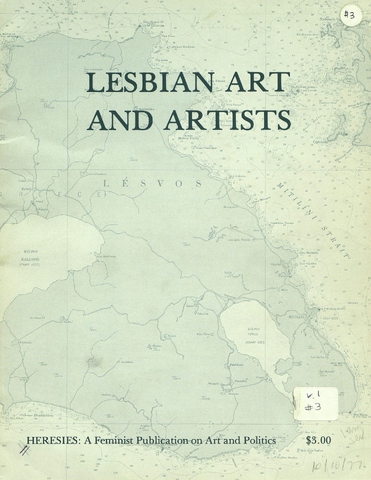Lesbian Art and Artists
Heresies Vol. 2, No. 1, Fall 1977
-
-
The Issue 3 Collective:
Cynthia Carr, Betsy Crowell, Betsy Damon, Rose Fichtenholtz, Louise Fishman, Su Friedrich, Harmony Hammond, Marty Pottenger, Amy Sillman, Christine Wade, Kathy Webster.
Collective Statement:
This issue of Heresies arises out of our need to challenge the heritage of secrecy, silence, and isolation which has been a necessity for lesbians who make art. Because we have no recognizable community with a sense of history, we seek to begin one by affirming and making visible the excellence of our efforts. As lesbians, we choose to create an issue devoted exclusively to work by lesbians in the context of a feminist publication. We understand that in this decision there exists an implicit danger of tokenism: that this may be the only issue of Heresies in which a substantial amount of lesbian material will appear. At the same time, the decision reflects our belief that feminist aesthetics and politics would not exist and will not continue to develop without the vision and energy of women whose sole commitment is to women.
Perhaps our greatest challenge as a collective has been to remain faithful to the truth of our experience, its beauty and its pain, as we present it to an audience which has punished us for our very existence within it. Because of our position within a predominantly heterosexual feminist journal, we had to struggle against the desire to make the definitive lesbian art issue. We resisted this pressure and created an issue which quite frankly reflects the political and esthetic bias of the majority of the collective. We share no single political position, yet biases which informed our choice of material were certainly conditioned by the fact that we are all lesbians, white, college-educated, and mostly middle class women who live in New York and have a background in the arts. Unique constraints governed our choice of selections: the unavailability of material by lesbians not ready to come out, or not willing to participate in a heterosexual journal: our own protectiveness which forced us to exclude material which we saw as dangerous, either because it presented ideas in an undeveloped manner, or because it invaded our privacy in such a way as to expose us to abuse and misunderstanding. In each and every instance in the selection of work, we insisted on a clear and responsible exposition of ideas.
The difficult process of selection of material always took us to a confrontation with our vulnerability, self-doubt, confusion and personal pain. We wish to thank the hundreds of contributors who, by submitting their work, risked a similar difficulty. It is clear to us that lesbians have merely begun an exploration of their unique experience through making and talking about their art.
An important responsibility rests with lesbians and with the feminist community: to vigorously seek out and publish lesbian art work in lesbian publications and in feminist journals such as Heresies. Without this effort, a feminist world view cannot be created.
-
-

